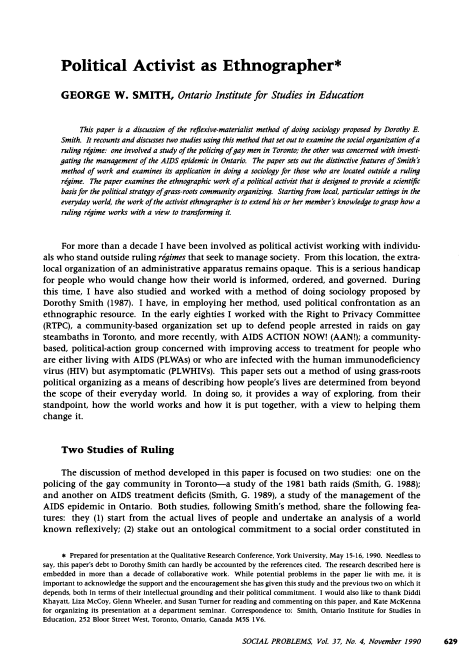
A Methodology for Movements & Activists
First published in the November 1990 issue of Social Problems, and later in the edited collection, Sociology for Changing the World: Social Movements/Social Research (2006), George Smith’s “Political Activist as Ethnographer” marked the emergence of a radically different method of “doing” activist sociology. In this piece, George extends Dorothy E. Smith’s formulation of institutional ethnography (IE) to develop a methodology and form of movement-based theorizing that was for social movements and for activists. While IE offers researchers an important feminist method of tracing social organization by starting from people’s everyday experiences, PAE provides researchers and activists with a more direct orientation toward social change by beginning from the perspective of political activists.
Activism as an Ethnographic Resource
One of the most significant contributions of George’s academic and activist work was his commitment to learning from activists, and from moments of confrontation with ruling regimes. Meetings, direct actions, and demonstrations are all important sites for knowledge production, where activists are already engaging in research and knowledge production. Unlike traditional social movement theory, the role of a PAE researcher is not to explain the work that activists are already doing, but to learn from that work in order to help determine more effective directions for activism (1990: 87).
The Ontological Shift

In Eric Mykhalovskiy and Kathryn Church’s “Of T-Shirts and Ontologies: Celebrating George Smith’s Pedagogical Legacies” (2006) we learn of the first time that Kathryn met George, who was sporting a t-shirt that declared “I have made the ontological shift” (2006: 72). In PAE and IE, “making the ontological shift” implies coming to understand the world as produced through people’s everyday activities and their coordination. As a theoretical and methodological tool, the ontological shift enables the researcher to look beyond speculation or ideological accounts of the social world, to instead investigate the social relations, in practice, that make those accounts possible.
Investigating Social Organization
In “Political Activist as Ethnographer” (1990), George describes his investigation into the social organization of the bathhouse raids in Toronto; as well as his research into the management of the AIDS epidemic in Ontario in the 1980s. In both sites of struggle, George uses his critical approach to research to explicate the textually-mediated relations of ruling coordinating these experiences (i.e., the acts of indecency section of the bawdy house section of the Criminal Code and its criminalization of queer sex, as well as the “AIDS as a death sentence” framing, which led government and medical officials to focus more on prevention and palliative care than delivering treatments to people living with HIV/AIDS). Rather than explaining these crises through concepts such as “homophobia,” “AIDS-phobia,” and “bureaucratic red tape,” George helped to reveal new starting points for activist resistance through changes to the Criminal Code of Canada on the one hand, and the development of infrastructure to manage the delivery of life-saving AIDS treatments on the other.
Interested in learning more about George Smith’s academic work? Check out the following resources:
- Sociology for Changing the World: Social Movements/Social Research (Frampton, Kinsman, Thompson & Tileczek 2006). For information and ordering, see here.
- George Smith reading list, compiled by members of the AAHP (available here).